무늬바다방울벌레
Caconemobius takarai (Oshiro
1990)
몸길이는 약 9-10 ㎜이며 흑갈색이다. 배 마디와 다리에 흐린 무늬가 있다. 성충이 되어도 전혀 날개가 나지 않는다. 해변의 바위 사이에 주로 살며 밤에 나타나 각종 유기물을 먹는다. 일본에도 분포한다.
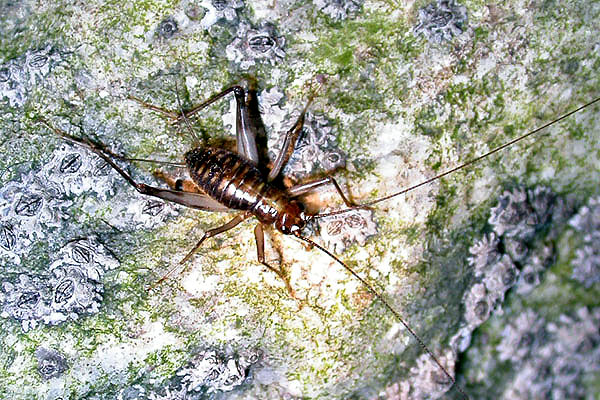
수컷
(Male)
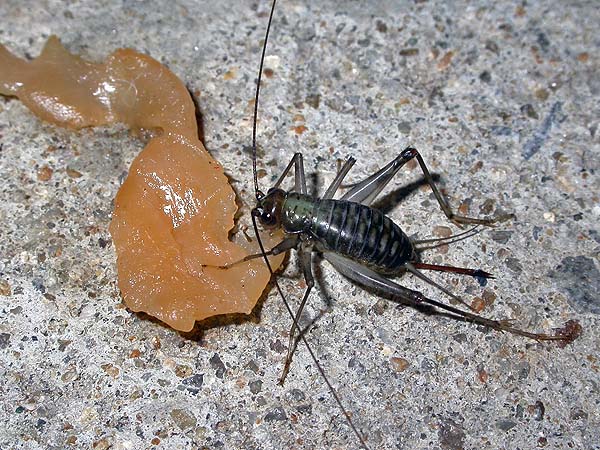
암컷
(Female)
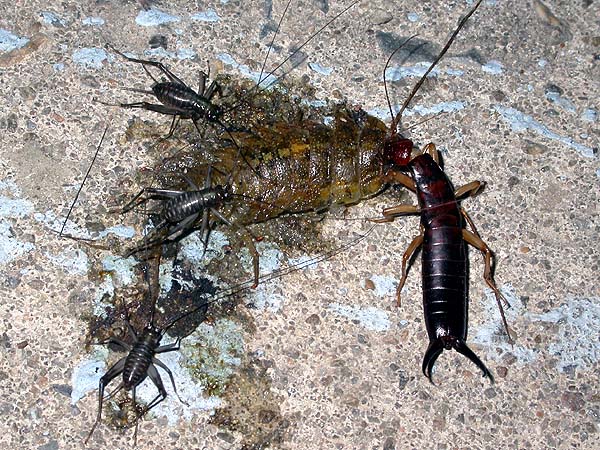
야간활동
(Nocturnal behavior)
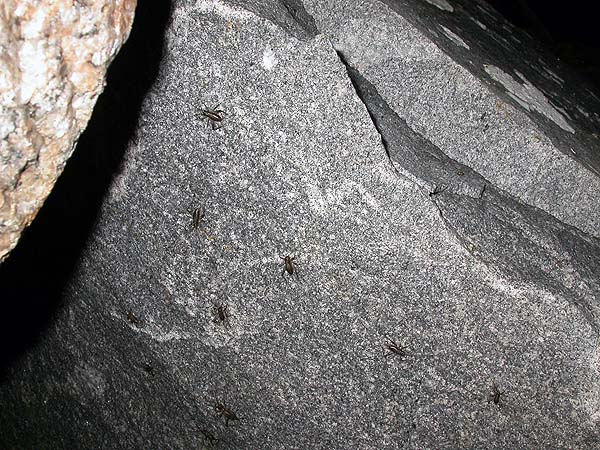
서식처
(Habitat)
Original description:
Parapteronemobius takarai
Oshiro 1990 Akitu 117: 1-6, figs. 1-8.
This species is closely related to
P. daitoensis,
but differs from the latter in the body size and markings, size
and shape of head, size and shape of scape of antennae, size and
shape of maxillary and labial palpi, shape and markings of pronotum,
number of hind tibial subapical spurs, and some other details.
Male.
Wingless. Body pale brown or brown. Body a little smaller than in
P. daitoensis, but larger than in P.
sazanami. Head and pronotum densely covered
with yellowish brown hairs and with brown bristles. Head in dorsal
view about 0.6 times as long as width and about 0.9 times as long
as pronotum. Rostrum dark brown and a little narrower than scape.
Vertex black or dark brown and occiput light brown, densely covered
with small brownish or yellowish hairs.
Face triangular
in frontal view. Frons with somewhat vertical long blackish pentagon
between antennal sockets. Eyes large, wedge-shaped to globular,
and brown with dark spots of various size. Median ocellus present,
but lateral ocelli absent. Antennae long, about 5 times as long
as body, filiform, brown, densely covered with small brownish hairs;
scape more or less depressed and a little longer than wide, produced
inwardly. Anetnnal socket white or yellowish white, bulkier than
in P. daitoensis.
Clypeus and labrum rather blackish brown and covered with yellowish
hairs.
Maxillary and labial palpi as shown in Figs.
3 and 4. Maxillary palpi becoming shorter in the order of 5th, 3rd,
4th, 2nd and 1st, basal segment about twice as long as wide and
5th segment about 4.6 times as long as wide. Labial palpi composed
of 3 segments, and distally becoming longer, each segment swollen
at the tip. Maxillary and labial palpi white or whitish brown and
densely covered with short brownish hairs.
Pronotum
trapezoid, pale brown in color and densely covered with yellowish
pubescence, with semicross-shaped yellowish marking at the center;
anterior margin dark brown, slightly wider than posterior one and
both margins with blackish bristles densely.
Legs
moderately long, slender, pale brown or brownish and densely covered
with blackish pubescence and several places covered with blackish
bristles. Fore and middle femora somewhat swollen at base. Hind
femora acutely swollen at base. Hind tibiae with 3 outer and 1 inner
subapical and 3 out and 2 inner apical spurs; 3 outer and 1 inner
subapical spurs quite the same length, but 2 inner apical spurs
much longer than outer ones.
Abdomen pale brown or
light brown with a dark brown band on posterior part of each tergite,
and densely covered with blackish brown pubescence. Ventral surface
of abdomen pale brown.
Cerci yellowish brown, medium-sized,
moderately swollen at base and densely covered with blackish brown
pubescence; with three kind of hairs, very long ones, short ones,
and swollen ones on basal part of cerci.
Female.
Wingless. Body pale brown or brown. General appearance similar to
the male, but slightly larger.
Ovipositor about 0.7
times as long as body, a little longer than cerci, rather slender,
moderately curved downwards, yellowish brown, with the apex dark
brown.
Measurements (in ㎜). Male: body length, 8.3-10.5
(9.2 in mean); head width (including compound eyes), 2.3-2.8 (2.6);
pronotal length, 2.2-2.8 (2.6); hind femoral length, 8.0-8.4 (8.2);
hind tibial length, 6.0-6.7 (6.4); cercal length, 4.6-5.3 (5.1).
Female:
body length, 9.7-11.6 (10.3); head width, 2.8-3.4 (3.1); pronotal
length, 2.3-2.8 (2.6); hind femoral length, 8.5-9.1 (8.7); hind
tibial length, 7.1-7.7 (7.3); cercal length, 4.7-5.5 (5.2); ovipositor
length, 6.7-7.4 (7.1).
Type series. Holotype: ♂,
shore at Maekago-minato, Takara Island, the Tokaras, 24. X. 1988,
Y. Oshiro leg. Paratypes: 5♂, 4♀, same data as the holotype. The
holotype and 2 paratypes are preserved in the collection of the
Osaka Museum of Natural History, Osaka, and the other paratypes
will be retained in my collection.
Japanese name:
Takara-umikorogi.
Etymology. The specific name is
dedicated to Dr. Tetsuo Takara, Professor Emeritus, University of
the Ryukyus, Okinawa, who has given me helpful advice over a long
period of time.
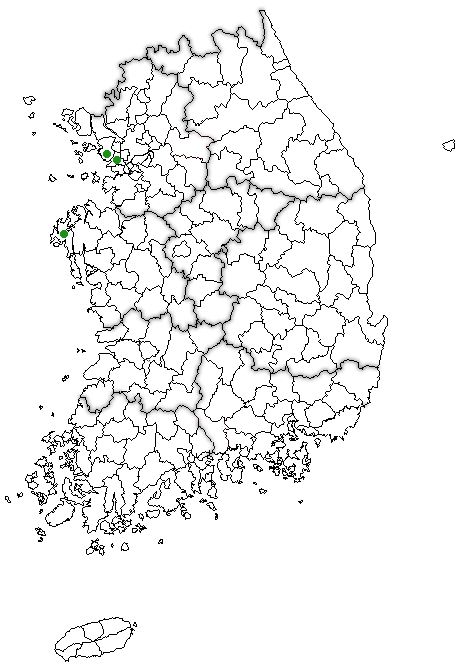
<참고문헌>